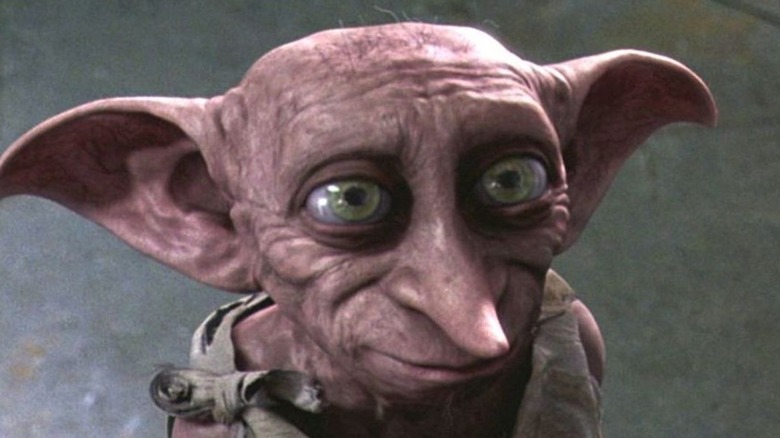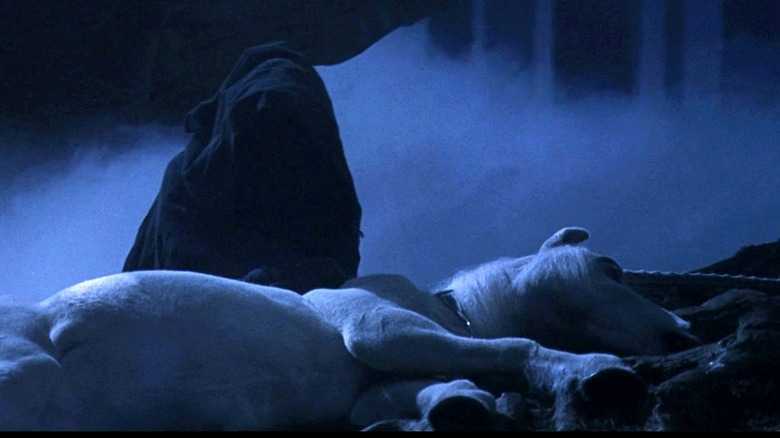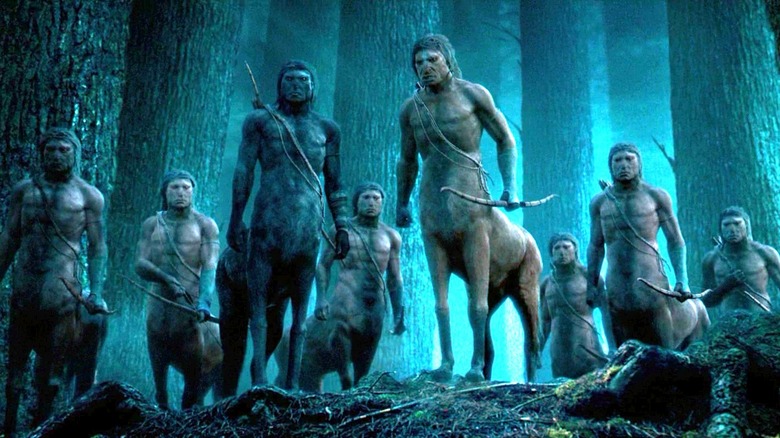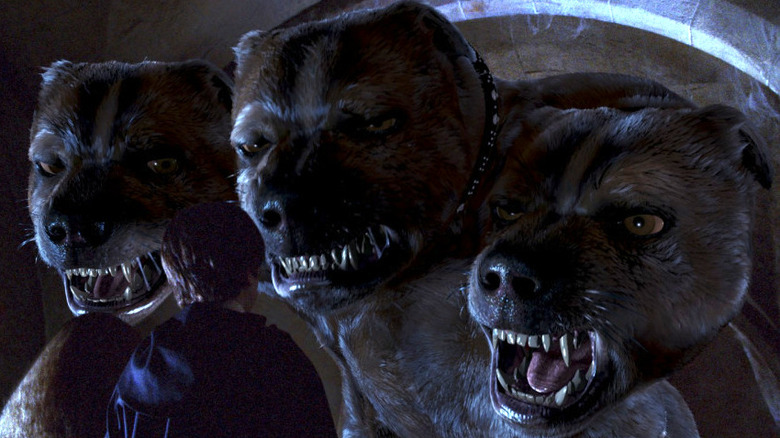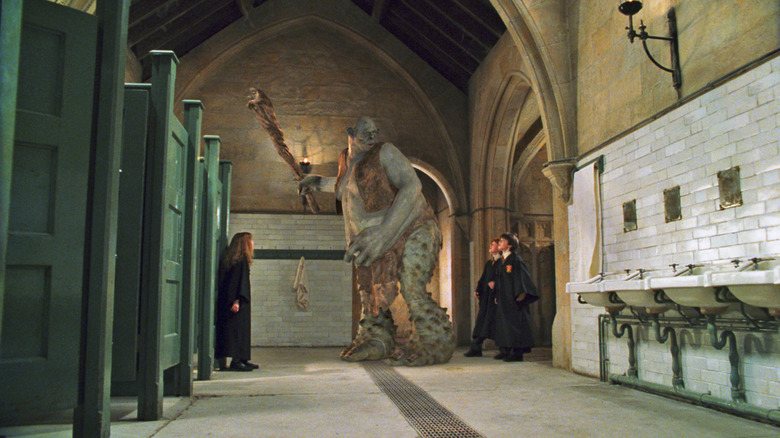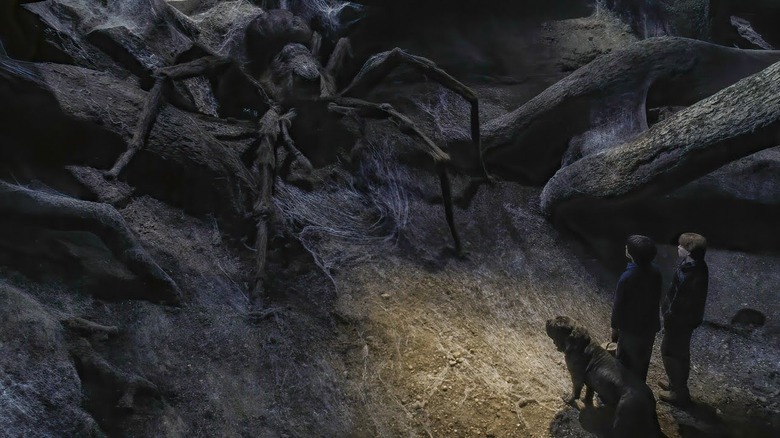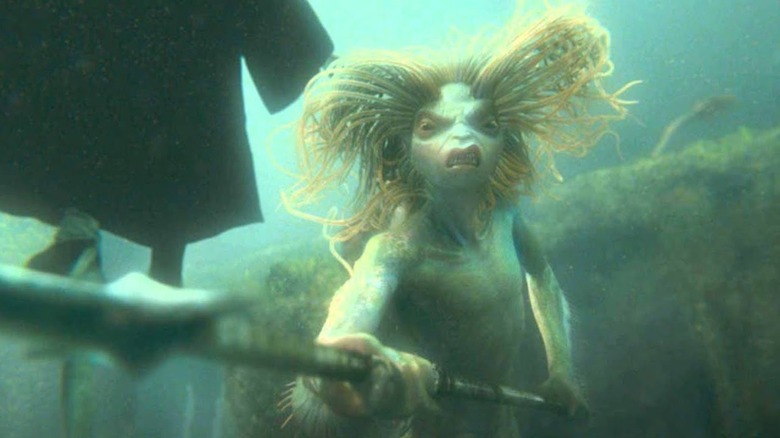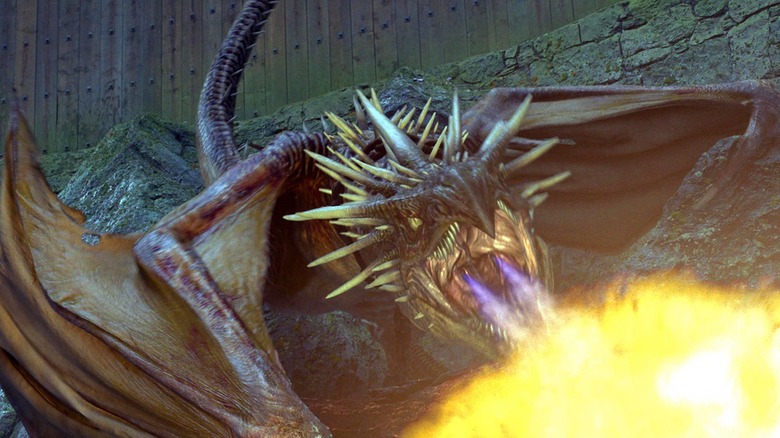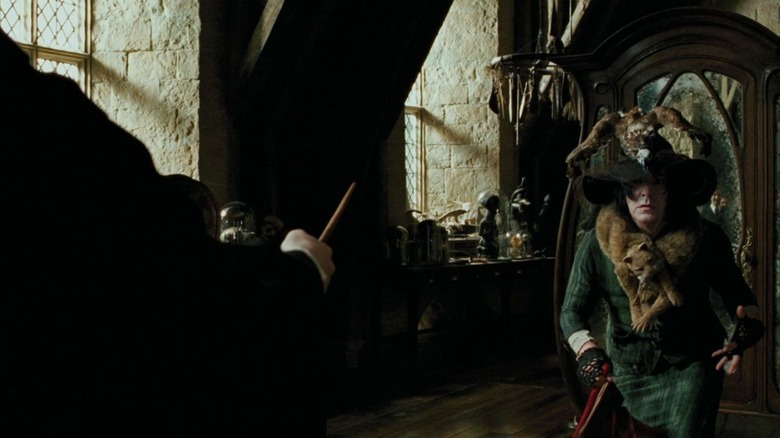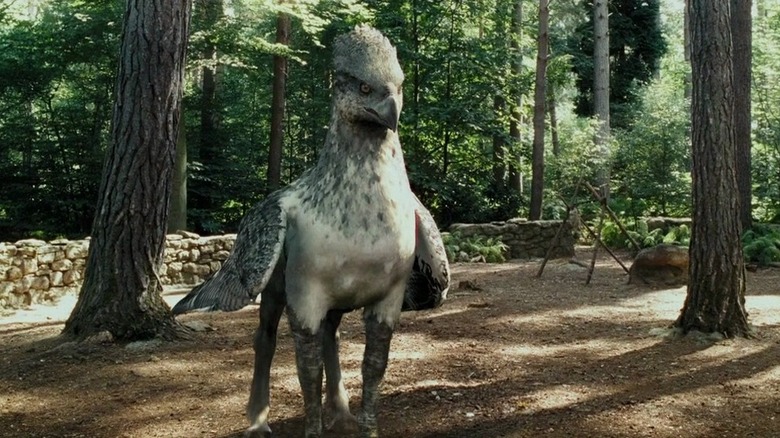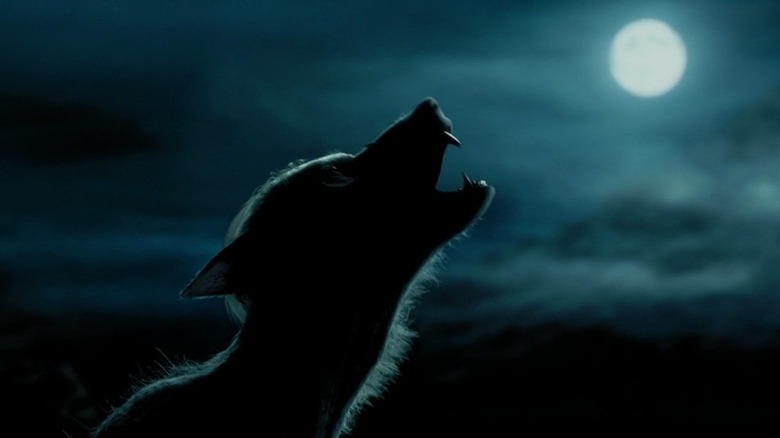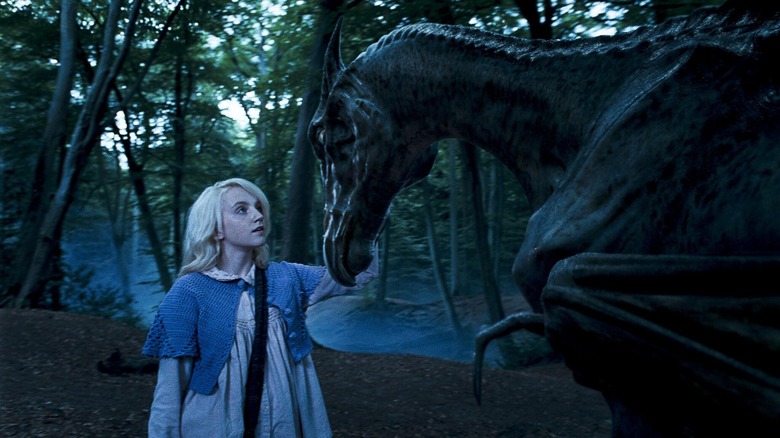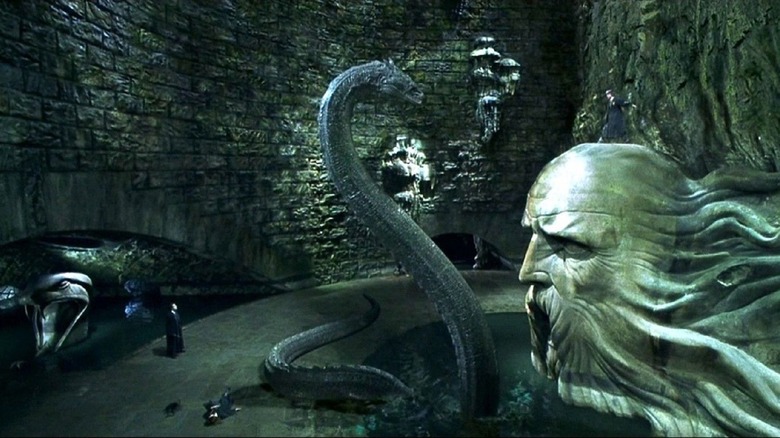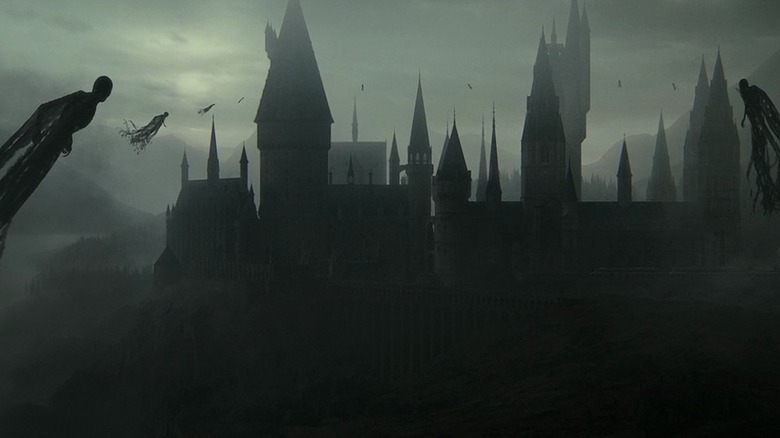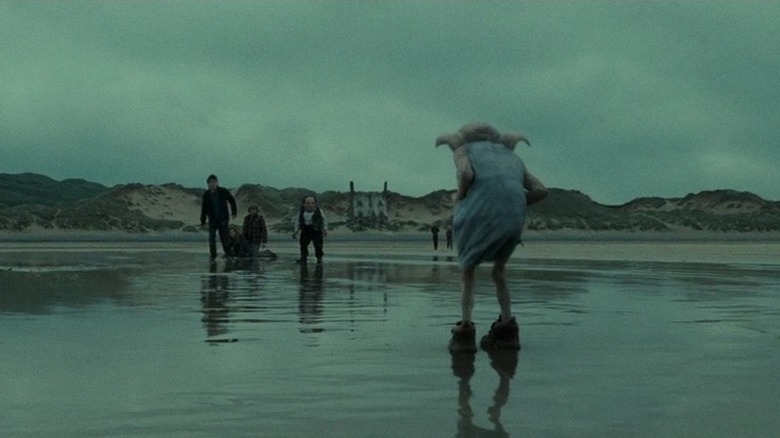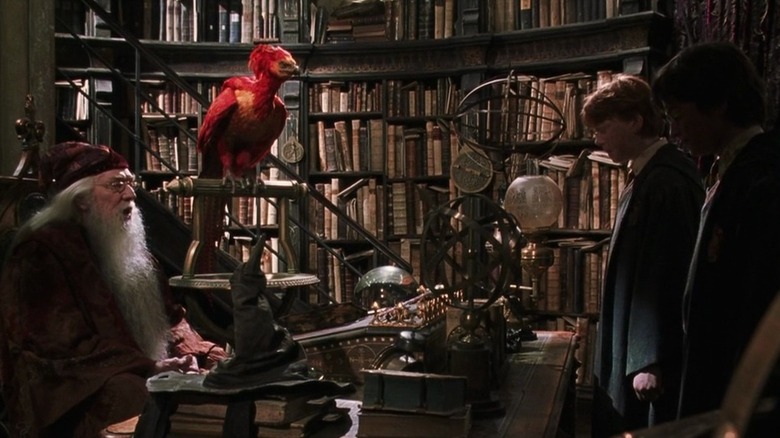Creatures In Harry Potter Movies Ranked By How Cool They Are
The "Harry Potter" series tells the story of a poor young orphan named Harry whose life changes when he is offered the chance to study at a school called Hogwarts. Only this isn't like a super-exclusive school that sets you up for getting into Harvard when you graduate or something. No, Hogwarts is straight-up a school for witchcraft and wizardry.
To cap it off, Harry discovers upon arriving at Hogwarts that he is at the center of a vast conspiracy involving the most evil wizard of all time, Lord Voldemort. That means not only does Harry have to deal with lessons and teachers, but also way more life-threatening situations than a lot of military veterans have ever faced. Much of the danger that Harry comes into contact with has to do with magical creatures that abound in the wizarding world.
The "Harry Potter" books featured a host of fascinating creatures. The movies based on the books could not include as many magical beasts for want of time, but they still feature many memorable creatures of the magical variety that have since become a part of pop culture. Let's take a look at some of the coolest creatures we have seen across all eight "Harry Potter" films.
15. Unicorns
Unicorns have been an iconic part of the fantasy media landscape long before "Harry Potter" came along. Each new story which features unicorns puts its own spin on the creatures, which are usually depicted as large horses with a single horn growing out of the middle of their forehead. The very first "Harry Potter" movie introduces viewers to a unicorn that is in pretty bad shape.
Harry and his 11-year-old friends are sent into the deadly Forbidden Forest filled with giant bloodthirsty spiders and vicious centaurs as punishment for breaking curfew (because the teachers at Hogwarts might actually be sadists). There, Harry discovers a fallen silver unicorn having its blood sucked by a dark hooded creature.
It is later mentioned that the blood of unicorns can be used to avoid imminent death. But the punishment for killing something so pure is to live a cursed "half-life." Later on in the books, Hagrid introduces some golden unicorn foals to his "Care of Magical Creatures" class and informs them that the foals will take on their classic silver color around the age of two. Unfortunately, the tiny golden unicorns did not make it into the movies.
14. Centaurs
A group of centaurs live in the Forbidden Forest next to Hogwarts and are on fairly friendly terms with Rubeus Hagrid, the gamekeeper of the school. But that friendship does not extend to the rest of humankind. Centaurs are reserved and rather conceited creatures who prefer to stay out of wizarding affairs.
In "Harry Potter and the Sorcerer's Stone," Harry is saved from the creature drinking the unicorn's blood by a centaur named Firenze. His fellow centaurs were not happy with Firenze coming to Harry's aid, and it even leads to a heated argument as Firenze declares that he has no intention of standing by the sidelines and watching great calamity occur when he could do something to stop it by working alongside wizards.
The next time centaurs show up in "Harry Potter and the Order of the Phoenix," they are having a problem with Hagrid keeping his half-brother Grawp in their forest. Later they were further incensed when Dolores Umbridge invaded their sanctum and tried to order them around on behalf of the Ministry of Magic. The centaurs' response was to carry Umbridge off deeper into the forest, where they did unspeakable things to her.
13. Fluffy
While many magical creatures in "Harry Potter" are evidently based on older fantasy archetypes, others are harder to pin down to a specific fictional species. One such creature is "Fluffy," the giant three-headed dog guarding the room at the end of the "Forbidden Corridor" in the first movie.
Clearly, Fluffy is a PG-13 version of the giant multi-headed dog named Cerberus that shows up in Greek mythology as a servant of Hades who keeps a watch over the gates of the underworld so no soul could ever escape. Fluffy is not nearly as evil as Cerberus, however, and is actually Hagrid's pet who was loaned to Dumbledore to keep watch over the hiding place of the fabled "Philosopher's Stone."
While Fluffy's appearance is formidable, he loses some "coolness" points for having a pretty lame weakness. Like Cerberus, Fluffy cannot resist falling asleep upon hearing music. Even if that "music" was an inexperienced Harry playing the flute despite having had no proper training. Fluffy did not play a major role in the "Harry Potter" saga moving forward, which is ironic because Hogwarts desperately needed its services as a guard dog five years later when Draco Malfoy let loose an army of Death Eaters on the castle grounds.
12. Trolls
Early on in "Harry Potter and the Sorcerer's Stone," back before Harry had made an annual habit of tangling with either Lord Voldemort or one of his minions, he was still just a young kid who thought the most stress he would have to deal with at Hogwarts would be through exams and Snape's relentless bullying.
But that changed on the day timid Professor Quirrell came running into the great hall screaming about a troll that had been let loose in the castle. While the rest of the school panicked, Harry and Ron realized Hermione was stuck in the same area as the troll and raced off to rescue her. Thus viewers were treated to one of the best action scenes in early "Harry Potter" movies as Harry, Ron, and Hermione worked together to take on the towering troll wielding a giant club.
While the troll presented an impressive front and was the third-largest creature Harry ever faced (after the dragon and the basilisk), it did go down rather quickly after being struck by its own club. It is, however, implied that Harry and the others managed to beat the troll through sheer luck, and a more experienced wizard would not even have been able to penetrate the troll's magic-proof skin with curses or enchantments.
11. Acromantula
A running theme throughout "Harry Potter" is Hagrid's incomprehensible love for all manners of creatures that would give the average person nightmares. One such creature was Aragog, a giant spider, also known as an acromantula. Hagrid managed to get his hands on the egg that hatched to give birth to Aragog while he was still a student at Hogwarts, and he then tried to raise it in secret.
Hagrid was expelled from the school when Aragog was discovered, and most people assumed it was the deadly creature from the Chamber of Secrets that had been attacking students. Despite the trouble it brought upon him, Hagrid did not give up on Aragog, who managed to escape to the Forbidden Forest and thereafter raised an army of acromantulas.
As far as "coolness" goes, Aragog gets extra points for not being a mindless beast but actually being able to talk to humans intelligently. On the other hand, it loses a lot of points for disregarding its friendship with Hagrid and being okay with its children killing and eating Harry and Ron when they ventured into the Forbidden Forest looking for answers about the Chamber of Secrets. The acromantulas did make up for it slightly during the final "Battle of Hogwarts," when they attacked Voldemort's army.
10. Merpeople
In fantasy fiction, merpeople are mostly represented by their females, alluring mermaids who may invite sailors to their doom, or fall in love with humans and venture on land if the story is being told by Disney. But the merpeople that show up in "Harry Potter and the Goblet of Fire" are not nearly as interesting as all that.
During the second task of the Triwizard Tournament, Harry and the other champions venture into the Great Lake next to Hogwarts to retrieve the people they love the most, who have been placed under a magical sleep and tied to the bottom of the lake where they are guarded by a contingent of merpeople.
When Harry tries to save not only Ron but the other captured folks as well, the merpeople threaten him with violence. This starts a short brawl, at the end of which Harry manages to save not only Ron but Fleur Delacour's little sister as well. Despite breaking the rules, the merpeople prove they are not complete jerks when they tell Dumbledore about Harry's attempts to save everyone, and help him win the task.
9. Dragons
The most popular badass creatures in fantasy fiction are generally accepted to be dragons. The very first dragon Harry and the others encountered in the first movie was an adorable little baby dragon named Norbert, secretly being raised by, you guessed it, Hagrid. Norbert did not have much of a role to play in the story beyond getting Harry and his friends sent to the Forbidden Forest.
The next dragon Harry encountered was much more impressive. During the first Triwizard Tournament, Harry goes up against a Hungarian Horntail, widely considered the most dangerous breed of dragon in existence. The Horntail was a nasty customer, who very nearly managed to kill Harry while he was flying around on his broomstick.
The next and final time Harry had a run-in with a dragon was not nearly as stressful. While escaping from Gringotts, Harry and Hermione unchain the massive but blind dragon chained to the bottom of the bank. The dragon busts its way out of the building, ignoring the two tiny humans who had managed to clamber on to its back.
8. Boggart
Not all magical creatures are about size and physical weapons. Some, like the boggart, are more into psychological warfare. The creature was introduced in "Harry Potter and the Prisoner of Azkaban" during the very first "Defense Against the Dark Arts" lesson conducted by Remus Lupin.
The boggart is a shape-changer that likes to hide in small and dark corners. When threatened by a human, it appears before them in the shape of their worst nightmare. It takes a great deal of willpower not to panic in the face of a boggart attack, a lesson Harry had to learn the hard way after the boggart kept turning into a dementor in front of him and making him pass out.
As cool as boggarts are, they don't have much to do with the story beyond helping Harry learn how to summon a Patronus to repel dementors. Despite the threat they pose, boggarts are not inherently evil creatures, and mostly just want to be left alone in their dark corner of the attic or cupboard.
7. Hippogriff
What do you get when you cross a giant eagle with a giant horse? You get the hippogriff, a creature that looks like it was born to swoop down on unsuspecting humans and carry them off to its nest to be disemboweled. But despite their scary appearance, hippogriffs lean more towards their loyal horse side than their ruthless eagle side.
Buckbeak, the hippogriff, was introduced to Harry and his friends during a "Care of Magical Creatures" lesson. The creature immediately won over the hearts of viewers by attacking Draco Malfoy in the middle of a taunt and making the other Slytherins almost wet their pants. Unfortunately, the attack also meant that Buckbeak was perceived as a threat to humans and was sentenced to be executed by the Ministry of Magic.
This was an important part of the main plot of "Harry Potter and the Prisoner of Azkaban." After discovering the innocence of his convicted godfather, Sirius Black, Harry worked with Hermione to go back in time, prevent Buckbeak's execution, and allow Sirius to escape on the flying creature's back. Buckbeak was a loyal friend to Sirius when the latter was living in the wild following his escape. The magical creature also aided Harry's allies in the climactic Battle of Hogwarts and was generally one of the coolest non-talking characters in the series.
6. Werewolves
A werewolf is a human being who can turn into a human-wolf hybrid in the light of the full moon. The "Harry Potter" series explored both the tragedy and the menace of the Werewolf legend through two characters, Remus Lupin and Fenrir Greyback, both of whom had the condition which turned them into rampaging beasts during a full moon.
Lupin was bitten at an early age, and felt doomed to a life of otherness and misery as a result of being a werewolf. Thanks to Dumbledore's efforts, Lupin was able to attend Hogwarts despite his condition. Despite the confidence this gave him, Lupin never stopped seeing himself in a negative light, and was terrified of getting married and passing on his condition to any potential offspring.
On the other hand there was Greyback, the werewolf who had bitten Lupin in the first place. But that was no accident. Greyback believed that his condition was a superpower rather than a weakness, and wanted to raise an army of werewolves to take over the wizarding world. His philosophy was to bite victims in their youth, and raise them away from their families to become his brainwashed disciples. Due to his beliefs and the number of werewolves under his command, Greyback was one of the most dangerous villains in the entire "Harry Potter" saga.
5. Thestrals
When it comes to genuinely disturbing creatures, few can compete with the thestrals that show up in "Harry Potter and the Order of the Phoenix." The creatures take the shape of winged horses. But with scaly, reptilian skin, and they can only be seen by someone who has personally witnessed a person die.
Despite their scary appearance and connection to death, the thestrals are surprisingly cool creatures. They had been drawing the carriages that take students from the Hogwarts Express to Hogwarts castle since the start of the "Harry Potter" saga, but Harry could not see them before because he had not personally witnessed anyone dying until the end of "Harry Potter and the Goblet of Fire."
Even after being discovered by Harry, they pose no threat to him or to the other students. In fact, they are instrumental in getting Harry and his allies out of Hogwarts and into the Ministry of Magic in "Harry Potter and the Order of the Phoenix" on their quest to save Sirius from the Death Eaters. While it seems like thestrals would be the perfect mounts for Death Eaters, the creatures seem aligned to the side of good instead.
4. Basilisk
Few creatures in the "Harry Potter" movies have as fearsome a reputation as the dreaded basilisk. The creature takes the form of a giant serpent that can grow up to 50 feet in length. It is born from a chicken's egg hatched under a toad. The basilisk has highly venomous fangs and spell-resistant skin. But its ultimate weapon is its stare, which can instantly kill or petrify anyone who meets its gaze directly or indirectly.
The events of "Harry Potter and the Chamber of Secrets" were set in motion when Ginny Weasley unwittingly awakened the ancient basilisk that had been lying dormant in the bowels of Hogwarts castle since the time of Salazar Slytherin. Once free, the basilisk embarked on a terror spree, steadily adding more victims to its list that included a ghost and several students.
When Harry entered the Chamber of Secrets to confront the basilisk, the only reason he stood a chance against the fearsome animal was due to the help of Fawkes the phoenix. Even then, the basilisk nearly succeeded in killing Harry after biting him. But the tears of Fawkes proved equal to the task of removing the venom from Harry's veins. One shudders to imagine how much more deadly Voldemort's army would have been if he had managed to add a few more basilisks to his team.
3. Dementors
In the grand tradition of the Ring Wraiths that served Sauron in "The Lord of the Rings," the "Harry Potter" series had dementors. Foul creatures whose sole purpose was to suck all the happiness out of any person they came into contact with. Apart from being the literal definition of a "killjoy," a dementor's most deadly weapon is its "kiss," which refers to the act of sucking the soul of a person out of their body.
Dementors are so powerful that they are used to guard the prison of Azkaban, filled with the most desperate and dangerous criminals in the country. There is no need for jails in Azkaban since the dementors sap all the joy and hope out of their prisoners so utterly that they are consumed with eternal misery and are unable to even think about escaping.
The fate of the "Dementor's Kiss" is considered the worst thing that can happen to someone. In "Harry Potter and the Goblet of Fire," Harry was horrified to learn that Barty Crouch Jr. had been subjected to the kiss, despite the latter being responsible for the death of Cedric Diggory and Voldemort's return to power. Unsurprisingly, the dementors flocked to Voldemort's side after his return under the promise of being allowed to feast freely on any and every human, wizard and muggle alike.
2. House-elf
Elves are another near-permanent staple of the fantasy genre. Whether helping Santa make toys or helping Gandalf battle orcs, elves are usually depicted as powerful creatures who deign to help humanity out of the goodness of their hearts. "Harry Potter" puts a heartbreaking spin on this mythology by introducing "house-elves," particularly Dobby the house-elf.
House-elves are powerful magical creatures. Unfortunately, they are bound by magic to obey the whims of a particular wizard family. In Dobby's case, that meant following the rules set by the Malfoy family, which included brutally punishing himself for the slightest transgressions. Despite having to subject himself to regular beatings for helping Harry, the little house-elf continued to do so across several movies, right up until the heartbreaking moment of his death while saving Harry and his friends.
Much has been written about house-elves being the "slaves" of the wizarding world, a fact that everyone from Harry to Albus Dumbledore seems strangely okay with. Whatever you might think of the ethics of their race's subjugation, house-elves are a fascinating part of "Harry Potter," even if their role in the story was toned down for the movies.
1. Phoenix
If snakes represent all that is evil in the world of "Harry Potter," from the basilisk to Nagini, then Fawkes the Phoenix, Dumbledore's personal pet, is a representation of all that is good and kind in the wizarding world. Little wonder that Dumbledore chose to name his secret army that he built to fight dark forces "The Order of the Phoenix."
In its very first movie appearance, a very old Fawkes startles Harry by bursting into flames without provocation, only to be reborn again within moments as a young, healthy chick. This idea of losing your old self and becoming something new and better through a literal "trial by fire" was carried over through the mental journeys of Harry and many of his allies, who went from being innocent students to battle-hardened warriors by the end of the saga.
Fawkes also took on the fearsome basilisk, gouged out its eyes, and saved Harry from its deadly venom. Later on, Dumbledore was able to escape from the ministry of magic by simply grabbing on to Fawkes and teleporting away with it. Finally, the red-and-gold bird exemplified qualities of loyalty and courage by coming to Harry's aid in the Chamber of Secrets after he had sworn his allegiance to Dumbledore and leaving Hogwarts forever after the passing of its master in "Harry Potter and the Half-Blood Prince."
